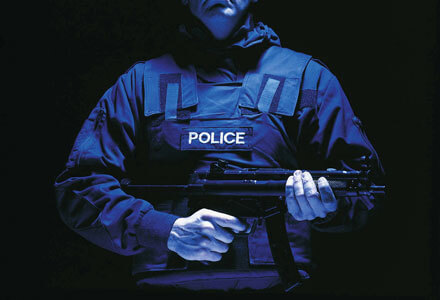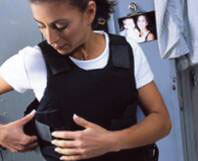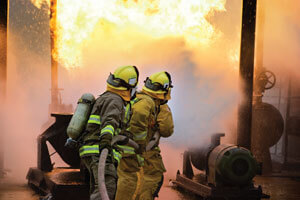At any given moment, all over the world, people are putting their lives on the line to help others. A doctor treats a patient who’s been exposed to a virus and, in the process, puts her own health at risk. A firefighter charges into a burning building to rescue a person who’s trapped and, with each second that goes by, increases his own chances of succumbing to the smoke and flames. A police officer responds to the scene of a domestic dispute and is shot by a fleeing suspect.
 In these scenarios, certain individuals stand between those whom they serve and the imminent danger that threatens their lives. What makes a person capable of this level of self-sacrifice? Certainly, there’s an element of bravery, a willingness to accept risk, a deep care for others and a strong sense of duty. Yet in many of these life-threatening situations, law enforcement officers, medical professionals, firefighters and emergency medical technicians are aided and sometimes even saved by the very uniforms they wear and gear they carry.
In these scenarios, certain individuals stand between those whom they serve and the imminent danger that threatens their lives. What makes a person capable of this level of self-sacrifice? Certainly, there’s an element of bravery, a willingness to accept risk, a deep care for others and a strong sense of duty. Yet in many of these life-threatening situations, law enforcement officers, medical professionals, firefighters and emergency medical technicians are aided and sometimes even saved by the very uniforms they wear and gear they carry.
From bullets to bacteria to blazes, uniforms protect those who serve from the dangers they face, and uniform manufacturers constantly improve their offerings to rise to the challenges that these dangerous lines of work present. Yet, as fibers and fabric technologies evolve and merge with each other, manufacturers are creating products that are at once astoundingly advanced and increasingly difficult for the average uniform retailer to understand. Uniform retailers are now expected to know more than ever before, and with lives on the line, the stakes are high.
The year 2005 was a pivotal one for Officer Corey Grogan of the Atlanta County Police Department. On Oct. 28th of that year, Officer Grogan and his partners were serving an arrest warrant to a suspect who responded by firing shots from his .45-caliber pistol. Officer Grogan attempted to get his lieutenant out of the line of fire and, in the process, was struck twice. Grogan and his lieutenant took cover and waited for the backup unit to arrive. Grogan received medical treatment on the scene and was advised that he had holes in his shirt.
“I wasn’t aware that I had holes in my shirt. I felt the impact of the round hitting me, but I didn’t think of anything else other than trying to get out of the area I was in, because it was an unsafe area,” he recounts. “I unzipped my shirt, and I realized I had two holes in my bulletproof vest, which made me feel really good to know that I had holes in my vest instead of holes inside me.”
Officer Grogan’s experience was also significant for the International Association of Chiefs of Police and DuPont. In 1987, the IACP teamed up with DuPont to form the IACP/DuPont Kevlar Survivors’ Club, a group dedicated to recognizing law enforcement professionals who have survived potentially fatal or disabling injuries as a result of wearing body armor. Officer Grogan became the 3,000th member of the group and was inducted in March 2006 during the IACP’s annual Day on the Hill event in Washington, D.C.
Grogan’s induction, though celebratory, also served as a reminder of the countless other lives lost as a result of improper body armor use or complete failure to wear body armor. Former IACP President Mary Ann Viverette remarked, “Unfortunately, far too many of today’s on-duty field and investigative personnel – an estimated 40 percent – still do not routinely wear soft body armor. Our hope is survival stories like Officer Grogan’s will inspire others to wear vests and, where needed, upgrade outdated vests.”
 Modern body armor traces its history back to 1965, when DuPont research scientist Stephanie Kwolek developed Kevlar. Like so many great innovations, it was discovered somewhat by accident. Kwolek was working with a team at DuPont to create a strong, lightweight fiber for use in tires. She was mixing polymers and created a cloudy batch that was considered trash by other researchers. However, she decided to keep the batch, and asked the spinneret operator to spin it for her, despite his opposition to the idea. The resulting fiber, unlike nylon, did not break, was five times stronger than steel on an equal-weight basis, and was immediately recognized by her supervisor as a remarkable discovery. This para-aramid synthetic fiber laid the foundation for the new field of polymer chemistry and formed the basis for the body armor still used today by law enforcement, public safety and military personnel worldwide.
Modern body armor traces its history back to 1965, when DuPont research scientist Stephanie Kwolek developed Kevlar. Like so many great innovations, it was discovered somewhat by accident. Kwolek was working with a team at DuPont to create a strong, lightweight fiber for use in tires. She was mixing polymers and created a cloudy batch that was considered trash by other researchers. However, she decided to keep the batch, and asked the spinneret operator to spin it for her, despite his opposition to the idea. The resulting fiber, unlike nylon, did not break, was five times stronger than steel on an equal-weight basis, and was immediately recognized by her supervisor as a remarkable discovery. This para-aramid synthetic fiber laid the foundation for the new field of polymer chemistry and formed the basis for the body armor still used today by law enforcement, public safety and military personnel worldwide.
Kevlar fibers are now used in an astounding number of products, including heat-resistant gloves, bike helmets, jet engines and fiber optics. The fibers themselves have not changed over the years, but the denier (fiber diameter) of the Kevlar and the way that the Kevlar is woven now allow for a wide variety of uses. Body armor designed to offer bullet resistance, for example, is woven differently than body armor that’s meant to provide stab resistance. Yet the basic principle is the same; protective vests are typically made with many layers of Kevlar fabric, each of which is comprised of very strong, tightly woven fibers. Together, these act as a net, slowing the speed of a bullet, ice pick, knife, or other weapon, spreading the impact over a greater surface area. This reduces impact to the wearer and prevents penetration.
Multiple types of threat resistance can be combined, but this adds weight and cost to the vests, both of which police departments and other agencies try to avoid. Most police departments assess the threats presented by the areas in which they serve and order body armor that protects officers from those specific threats. This requires diligence and a dedication to keeping up with the latest information.
 According to Jeff Fackler, North American market segment leader for DuPont, it’s equally important for police departments to communicate their needs clearly. “It’s all about making sure that the police department or agency is well informed in terms of what the requirements and specifications are that they’re going to put on the manufacturer. They need to have clarity in their specifications,” explains Fackler.
According to Jeff Fackler, North American market segment leader for DuPont, it’s equally important for police departments to communicate their needs clearly. “It’s all about making sure that the police department or agency is well informed in terms of what the requirements and specifications are that they’re going to put on the manufacturer. They need to have clarity in their specifications,” explains Fackler.
In addition to specifying requirements, police departments should properly measure officers for their protective vests. They can order body armor using a few basic measurements, or they can submit detailed measurements for a more customized fit, which Fackler says is ideal. “You want something that’s tailored. There should be a degree of adjustability, and the officer should know how to adjust it. A good portion of the wearability, comfort and ergonomics has to do with fit and adjustability,” he says.
Many police and fire departments employ a body armor expert who can assess their body armor needs, communicate those to a manufacturer and make sure that each individual receives a vest that fits well. This helps ensure that officers are protected from the specific threats they face and ensures that they will wear their vests and wear them properly. However, many departments are eliminating these types of positions as part of an overall belt-tightening effort. This leaves an important gap to be filled and creates an opportunity for retailers who sell body armor to become an asset to police departments.
“It’s good to have a designated expert. If you have four salespeople or 40 salespeople, it’s good to have an expert,” says Fackler. He suggests reaching out to manufacturers, who are a great resource for information about body armor. The National Institute of Justice website is another resource, providing information regarding current and future research as well as the body armor standards with which police departments comply.
Additionally, within the next year, DuPont will be combining body armor information from a variety of sources into a kit that distributors can use. Smaller departments without a body armor expert can also leverage the knowledge of larger departments located within their region or state. The ultimate goal, says Fackler, should always be officer safety. “The key to success in serving the first responder market is to put the law enforcement officer first. Everything else will very effectively flow from there,” he says.
What’s next in the world of personal protective equipment? Fackler anticipates that existing technologies, such as ballistic protection and flame resistance, will become increasingly intertwined to meet the needs of modern emergency responders, who face many different types of threats. According to Fackler, some major uniform companies are already working on flame-resistant vest carriers, which would add an extra level of protection for police officers, firefighters and EMTs, who face new threats and challenges as their roles overlap.
Kevlar is inherently flame-resistant, and it will not continue to burn once the flame or source of heat is removed. Yet for modern firefighters, who face extraordinarily intense wildfires, blazes fueled by powerful chemicals and vicious acts of arson, Kevlar alone will not suffice. Fire departments instead rely on Kevlar’s cousin, a meta-aramid fiber from DuPont called Nomex.
 Like Kevlar, Nomex was developed in the 1960s, and it lends itself to a wide array of unexpected applications. Nomex was almost immediately embraced by electrical equipment manufacturers, and it is still the ideal material for electrical insulation. Strong, lightweight Nomex is also an important component of aircraft parts and boats, wind turbine systems, microwave ovens and even computers. In most of these applications, Nomex acts as an unsung hero, hidden within layers of other materials, surreptitiously providing strength and heat resistance.
Like Kevlar, Nomex was developed in the 1960s, and it lends itself to a wide array of unexpected applications. Nomex was almost immediately embraced by electrical equipment manufacturers, and it is still the ideal material for electrical insulation. Strong, lightweight Nomex is also an important component of aircraft parts and boats, wind turbine systems, microwave ovens and even computers. In most of these applications, Nomex acts as an unsung hero, hidden within layers of other materials, surreptitiously providing strength and heat resistance.
Yet when it comes to fighting fires, Nomex takes center stage, and the benefits are obvious. Not only is Nomex flame-resistant, but it also will not melt, drip or support combustion in the air. When exposed to the highest temperatures, Nomex carbonizes and becomes thick, somewhat like tar. This substance creates a highly protective barrier between the heat source and the skin, and it remains flexible until cool, allowing firefighters to stay protected while maintaining their freedom of movement. Additionally, Nomex provides protection from many chemicals.
One thing that Nomex can’t protect firefighters from, however, is the carcinogens that they are exposed to while at the scene of a blaze. Firefighters are exposed to many cancer-causing substances in their line of work, and this is becoming especially problematic with the proliferation of plastics as well as the synthetic chemicals that are increasingly more common. Unfortunately, the carcinogens to which firefighters are exposed don’t always stay at the scene of a fire. They linger on uniforms and are transported back to the station and even into firefighters’ homes. Some fire departments are combating this issue by installing special uniform washing machines in their stations. Others rely on industrial launderers. Retailers who sell turnout gear should be well informed of these unique concerns and prepared to answer questions regarding the washability of the items they sell.
Modern life is also creating new challenges for the medical industry. Every day, medical professionals risk healthcare-associated infections from increasingly antibiotic-resistant strains of bacteria. Additionally, doctors and nurses can sometimes act as vectors for disease transmission, carrying dangerous bacteria on their hands, equipment and even their uniforms. This is especially problematic in sensitive environments, such as those that treat immuno-compromised patients or in surgical settings.
 According to the Centers for Disease Control and Prevention, individuals who become infected with antimicrobial-resistant strains of bacteria are more likely to have longer hospital stays and may also be more likely to die from infection. Indeed, an estimated 99,000 people die each year in the United States as a result of healthcare-associated infections. Furthermore, certain infections, such as those caused by Acinetobacter and Methicillin-resistant Staphylococcus aureus (MRSA), occur most frequently in, and are sometimes exclusive to, healthcare settings and are becoming more prevalent. A recent study conducted by researchers in Israel found that over 60 percent of medical uniforms carried potential pathogens, and up to 14 percent carried antibiotic-resistant bacteria. These menacing strains of bacteria are even showing up in unexpected settings, such as dental schools.
According to the Centers for Disease Control and Prevention, individuals who become infected with antimicrobial-resistant strains of bacteria are more likely to have longer hospital stays and may also be more likely to die from infection. Indeed, an estimated 99,000 people die each year in the United States as a result of healthcare-associated infections. Furthermore, certain infections, such as those caused by Acinetobacter and Methicillin-resistant Staphylococcus aureus (MRSA), occur most frequently in, and are sometimes exclusive to, healthcare settings and are becoming more prevalent. A recent study conducted by researchers in Israel found that over 60 percent of medical uniforms carried potential pathogens, and up to 14 percent carried antibiotic-resistant bacteria. These menacing strains of bacteria are even showing up in unexpected settings, such as dental schools.
To combat healthcare-associated infections, some states are passing laws that require hospitals to report infections, and Medicare is now withholding two percent of payments from hospitals that don’t. Hospitals are feeling the pressure and are taking measures to cut their infection rates. For many of these hospitals, scrubs and other uniform items have become a major target of infection-reduction efforts, creating a new opportunity for uniform manufacturers.
One such manufacturer is New York-based XY Scrubs, founded by surgery resident Todd Ruiter last April. Ruiter had initially set out to create a fashion-forward line of scrubs for men but soon broadened his focus to include antimicrobial fabric technology. “As a surgery resident, I was dealing with this problem every day, as healthcare-associated infections really are becoming an epidemic in this country,” Ruiter explains. “It’s my belief, as a physician and surgery resident with ten years’ experience, that all textiles used in patient care in the hospitals will, in the near future, employ antimicrobials as a way to fight or limit the spread of HAIs.”
Ruiter researched antimicrobials and eventually chose a unique finish created by Dow Chemical Co., now trademarked as XY Defend. This finish, unlike other chemical treatments, is permanently bound to the fabric and will not wash away. Most unique is the way in which XY Defend interacts with bacteria. The finish, says Ruiter, “kills microbes by physically disrupting their architecture, literally shearing the microbe apart on contact, and therefore, it has not been shown to select for any resistance over 25 years of testing and application in consumer goods.”
Ruiter believes this level of constant protection from germs to be ideal. “If a majority of our scrubs will be harboring pathogenic bacteria by the end of a day’s work, the possibility for passing the germs along between patients throughout the day certainly exists. Antimicrobial treatments on hospital textiles, such as our XY Defend, may play a role in preventing this,” he says.
It’s a dangerous world, and those who find themselves on the frontlines of danger must take special precautions to protect themselves as they serve others. It’s up to uniform manufacturers and retailers to stay abreast of the risks that their end-users and customers face and the ways in which their products can protect them. While uniformed professionals dodge bullets, bacteria and blazes, it’s the uniform industry that can help strengthen their defenses.












